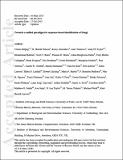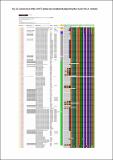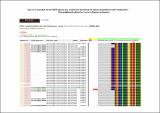Por favor, use este identificador para citar o enlazar a este item:
http://hdl.handle.net/10261/130958COMPARTIR / EXPORTAR:
 SHARE SHARE
 CORE
BASE CORE
BASE
|
|
| Visualizar otros formatos: MARC | Dublin Core | RDF | ORE | MODS | METS | DIDL | DATACITE | |

| Título: | Towards a unified paradigm for sequence-based identification of fungi |
Autor: | Kõljalg, Urmas; Dueñas, Margarita CSIC ORCID; Martín, María P. CSIC ORCID ; Tellería, M. T.; Larsson, Karl-Henrik | Palabras clave: | Bioinformatics DNA barcoding Ecological genomics Fungi Microbial diversity |
Fecha de publicación: | 2013 | Editor: | Wiley-Blackwell | Citación: | Molecular Ecology 22(21): 5271-5277 (2013) | Resumen: | The nuclear ribosomal internal transcribed spacer (ITS) region is the formal fungal barcode and in most cases the marker of choice for the exploration of fungal diversity in environmental samples. Two problems are particularly acute in the pursuit of satisfactory taxonomic assignment of newly generated ITS sequences: (i) the lack of an inclusive, reliable public reference data set and (ii) the lack of means to refer to fungal species, for which no Latin name is available in a standardized stable way. Here, we report on progress in these regards through further development of the UNITE database (http://unite.ut.ee) for molecular identification of fungi. All fungal species represented by at least two ITS sequences in the international nucleotide sequence databases are now given a unique, stable name of the accession number type (e.g. Hymenoscyphus pseudoalbidus|GU586904|SH133781.05FU), and their taxonomic and ecological annotations were corrected as far as possible through a distributed, third-party annotation effort. We introduce the term ‘species hypothesis’ (SH) for the taxa discovered in clustering on different similarity thresholds (97–99%). An automatically or manually designated sequence is chosen to represent each such SH. These reference sequences are released (http://unite.ut.ee/repository.php) for use by the scientific community in, for example, local sequence similarity searches and in the QIIME pipeline. The system and the data will be updated automatically as the number of public fungal ITS sequences grows. We invite everybody in the position to improve the annotation or metadata associated with their particular fungal lineages of expertise to do so through the new Web-based sequence management system in UNITE. | Descripción: | Kõljalg, Urmas et al. | Versión del editor: | http://dx.doi.org/10.1111/mec.12481 | URI: | http://hdl.handle.net/10261/130958 | DOI: | 10.1111/mec.12481 | ISSN: | 0962-1083 | E-ISSN: | 1365-294X | Reputación del trabajo revisado: | 90 |
| Revisiones por pares | 100Ver revisión de Spouge, John L 80Ver revisión de Schoch, Conrad |
| Aparece en las colecciones: | (RJB) Artículos |
Ficheros en este ítem:
| Fichero | Descripción | Tamaño | Formato | |
|---|---|---|---|---|
| paradigm_sequence-based_identification_fungi_Koljalg.pdf | 307,08 kB | Adobe PDF |  Visualizar/Abrir | |
| Fig_S1_Generation_global_key_technical_description.pdf | Generation of the global key: technical description | 103,77 kB | Adobe PDF |  Visualizar/Abrir |
| Fig_S2_global_key_annotations.pdf | Global key annotations | 2,58 MB | Adobe PDF |  Visualizar/Abrir |
| Fig_ S3_format_UNITE_reference_sequences_FASTA.pdf | Format of the UNITE reference sequences FASTA file available for download at unite.ut.ee and used by QIIME | 59,36 kB | Adobe PDF |  Visualizar/Abrir |
| Fig_S4_screenshot_UNITE_global_key.pdf | Screenshot of the UNITE global key workbench depicting the cluster UCL5_005639 | 4,47 MB | Adobe PDF |  Visualizar/Abrir |
| Fig_S5_screenshot_UNITE_global_key.pdf | Screenshot of the UNITE global key workbench depicting the species hypotheses SH5155686.05FU. This workbench allows to choose reference sequences | 2,23 MB | Adobe PDF |  Visualizar/Abrir |
CORE Recommender

La reputación del trabajo revisado es el promedio de las calificaciones de sus revisiones. Se necesitan al menos 2 revisiones, o la reputación del trabajo estará sin definir. Además, la reputación depende de la reputación de los revisores, que se obtiene de los comentarios que pueden hacer los autores sobre las revisiones recibidas. Cada vez que un trabajo recibe una nueva revisión o cada vez que una revisión recibe un nuevo comentario de autor, la reputación del trabajo revisado se recalcula. Más en Preguntas frecuentes.
SCOPUSTM
Citations
2.668
checked on 20-abr-2024
WEB OF SCIENCETM
Citations
2.524
checked on 27-feb-2024
Page view(s)
715
checked on 19-abr-2024
Download(s)
1.358
checked on 19-abr-2024
Google ScholarTM
Check
Altmetric
Altmetric
NOTA: Los ítems de Digital.CSIC están protegidos por copyright, con todos los derechos reservados, a menos que se indique lo contrario.
